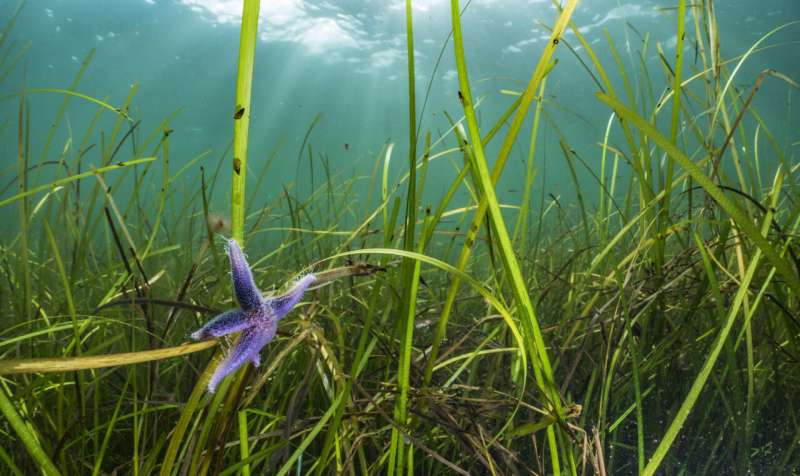This article has been reviewed according to Science X's editorial process and policies. Editors have highlighted the following attributes while ensuring the content's credibility:
fact-checked
peer-reviewed publication
trusted source
proofread
Eelgrass proves to be evolutionarily much younger than we thought

Eelgrass, one of the most abundant plants in the ocean, originated in Japan before spreading around the globe. Now, scientists have shed light on both when and how eelgrass adapted and evolved throughout its history.
Their research, published in Nature Plants, was able to assess absolute time estimates for major colonization events. It was previously assumed, due to the wide and varied geographic footprint of the plant, that eelgrass began colonizing the oceans about 3 million years ago. The study shows that figure is likely closer to a mere 250,000 years—with many key colonization events in the Atlantic ocean occurring within the last 40,000 years.
Eelgrass represents one of the largest carbon sinks in the ocean—occupying just 0.2% of the ocean floor, these meadows are responsible for almost one-third of carbon sequestered in the ocean.
In addition to providing a more detailed timeline of eelgrass's evolution, the study also shows the younger meadows in the Atlantic ocean are much less diverse than their Pacific Ocean ancestors—meaning these habitats are more vulnerable to the effects of a changing climate. Knowing more about how eelgrass evolved can help inform conservation efforts for at-risk populations.
Eelgrass is unique in that there are not many species able to occupy the regions where eelgrass flourishes. The plant can thrive in both frigid and tropical climates, growing off the coasts of Alaska and Norway, as well as California and Mexico. Based on the study, it would seem that once conditions became right for eelgrass, it was able to spread quickly and establish itself in a variety of new environments.
This all started roughly 250,000 years ago, when eelgrass traveled across the ocean current from Japan to colonize the southern California and Mexican coastlines. Roughly 100,000 years later, that Japanese eelgrass crossed the Pacific again, only this time it traveled north to Washington, British Columbia and Alaska.
Upon its arrival in Alaska, eelgrass quickly relocated to the Atlantic ocean through the Bering strait, which was previously inaccessible due to Arctic ice. However, much of eelgrass's colonization in the Atlantic ocean occurred during the last 20,000–40,000 years, establishing itself in Atlantic coastal areas off the shores of places including North Carolina, Norway and Portugal.
In order to develop a timeline like this, researchers would normally craft a genetic clock based on its divergence with a different species. However, eelgrass didn't have a reliable calibration tool in the form of another species, so the scientists had to use the genome itself.
Approximately 67 million years ago, the ancestor to eelgrass underwent a whole genome duplication event, doubling all of its chromosomes. Over time, the new and old chromosome copies begin to diverge and mutate relative to one another. This change occurs at a predictable rate, enabling researchers to use the genome assembly to calibrate their genetic clock.
Various researchers around the globe were each working on their own genetic clock to discover when eelgrass established itself in various locations. One group investigated changes in protein sequences, while others analyzed single point mutations across the genome or changes to the plant's chloroplast genome, each of which has its own rate of change. Once properly calibrated, each molecular clock independently provided timepoints of eelgrass's major global colonization events.
The U.S. Department of Energy Joint Genome Institute, a DOE Office of Science User Facility at Lawrence Berkeley National Laboratory, provided sequence resources—including the eelgrass genome assembly that enabled analysis of the whole genome duplication event—bioinformatics expertise, as well as sequencing for all global populations of eelgrass used in the study to reveal colonization events.
Looking ahead, scientists can use this information to assess what specific traits make older species of eelgrass in the Pacific Ocean so resilient. That in turn can help inform efforts to preserve the younger, more at-risk species that live in Atlantic Ocean environments and the plant's carbon sink capabilities.
More information: Lei Yu et al, Author Correction: Ocean current patterns drive the worldwide colonization of eelgrass (Zostera marina), Nature Plants (2023). DOI: 10.1038/s41477-023-01504-y
Journal information: Nature Plants
Provided by DOE/Joint Genome Institute



















